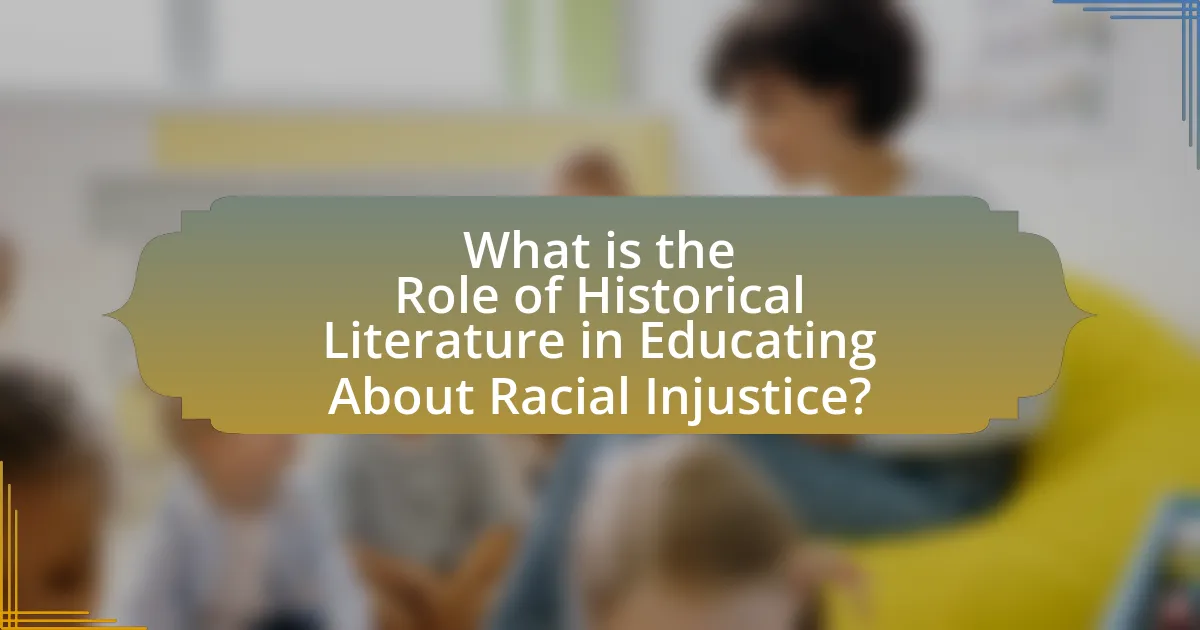The article examines the critical role of historical literature in educating about racial injustice, highlighting how narratives document the experiences of marginalized communities and reveal systemic inequalities. It discusses key themes such as systemic oppression, civil rights struggles, and the impact of colonialism, while emphasizing the importance of personal narratives in fostering empathy and understanding. The article also explores how historical literature influences societal awareness, policy changes, and educational practices, providing examples of influential works and authors that have shaped the discourse on racial injustice. Through this analysis, the article underscores the significance of integrating historical literature into educational settings to enhance critical thinking and engagement with contemporary racial issues.

What is the Role of Historical Literature in Educating About Racial Injustice?
Historical literature plays a crucial role in educating about racial injustice by providing narratives that document the experiences and struggles of marginalized communities. These texts often reveal the systemic inequalities and social injustices faced by these groups, fostering empathy and understanding among readers. For instance, works like “The Narrative of the Life of Frederick Douglass” illustrate the brutal realities of slavery and the fight for freedom, serving as a powerful tool for awareness and advocacy. Additionally, historical literature can challenge dominant narratives, offering alternative perspectives that highlight the voices of those affected by racial injustice, thereby enriching the discourse around race and equality.
How does historical literature contribute to understanding racial injustice?
Historical literature contributes to understanding racial injustice by providing firsthand accounts and narratives that illustrate the experiences of marginalized communities. These texts, such as “Uncle Tom’s Cabin” by Harriet Beecher Stowe and “The Narrative of the Life of Frederick Douglass,” offer insights into the systemic oppression faced by individuals and groups, highlighting the social, economic, and political factors that perpetuate racial inequality. By documenting personal stories and historical events, this literature serves as a critical tool for education, fostering empathy and awareness among readers. For instance, the portrayal of slavery and its aftermath in these works has been instrumental in shaping public perception and discourse around race relations in America.
What themes are commonly explored in historical literature related to racial injustice?
Common themes explored in historical literature related to racial injustice include systemic oppression, the struggle for civil rights, identity and belonging, and the impact of colonialism. Systemic oppression is often depicted through narratives that illustrate the laws and practices that enforce racial discrimination, such as Jim Crow laws in the United States. The struggle for civil rights is highlighted in works that chronicle movements and figures, like Martin Luther King Jr. and the Civil Rights Movement, showcasing the fight against inequality. Identity and belonging are explored through personal stories that reflect the experiences of marginalized communities, emphasizing the psychological effects of racism. The impact of colonialism is examined in literature that addresses the historical exploitation and subjugation of indigenous populations, revealing the long-lasting consequences of these actions. These themes are supported by historical events and documented struggles, making them integral to understanding racial injustice through literature.
How do narratives in historical literature shape perceptions of racial injustice?
Narratives in historical literature shape perceptions of racial injustice by providing context, personal stories, and critical analysis of past events that highlight systemic inequalities. For instance, works like “Uncle Tom’s Cabin” by Harriet Beecher Stowe played a significant role in shaping public opinion about slavery in the 19th century, illustrating the moral implications of racial injustice and influencing abolitionist movements. Additionally, historical accounts such as “The Narrative of the Life of Frederick Douglass” offer firsthand experiences of oppression, fostering empathy and understanding among readers. These narratives serve as educational tools that not only document injustices but also encourage reflection and dialogue about ongoing racial issues, thereby impacting societal perceptions and attitudes toward racial injustice.
Why is historical literature important in the context of racial education?
Historical literature is important in the context of racial education because it provides critical insights into the experiences and struggles of marginalized communities. This genre of literature documents historical events, social movements, and personal narratives that reveal the systemic injustices faced by racial groups. For example, works like “The Narrative of the Life of Frederick Douglass” offer firsthand accounts of slavery and the fight for freedom, illustrating the harsh realities of racial oppression. Such literature not only educates readers about past injustices but also fosters empathy and understanding, encouraging discussions about race and its implications in contemporary society. By engaging with historical literature, individuals can better comprehend the roots of racial inequality and the ongoing impact of these historical events on current social dynamics.
What impact does historical literature have on societal awareness of racial issues?
Historical literature significantly enhances societal awareness of racial issues by providing context, personal narratives, and critical reflections on past injustices. Works such as “Uncle Tom’s Cabin” by Harriet Beecher Stowe and “The Narrative of the Life of Frederick Douglass” have historically influenced public opinion and sparked discussions about slavery and racial inequality. These texts not only document the experiences of marginalized groups but also challenge prevailing societal norms, prompting readers to confront uncomfortable truths about racism. Research indicates that literature can evoke empathy and understanding, making complex social issues more accessible, thereby fostering a more informed and engaged society.
How does historical literature influence policy and social change regarding racial injustice?
Historical literature significantly influences policy and social change regarding racial injustice by shaping public perception and providing a narrative that highlights systemic inequalities. Works such as “Uncle Tom’s Cabin” by Harriet Beecher Stowe played a crucial role in galvanizing anti-slavery sentiment in the 19th century, directly impacting legislative actions like the Emancipation Proclamation. Additionally, the Civil Rights Movement was heavily informed by literature, including “The Autobiography of Malcolm X,” which articulated the struggles against racial oppression and inspired policy reforms such as the Civil Rights Act of 1964. These examples demonstrate how historical literature serves as a catalyst for awareness and advocacy, ultimately leading to tangible changes in laws and societal attitudes towards racial injustice.

What are the key examples of historical literature addressing racial injustice?
Key examples of historical literature addressing racial injustice include “Uncle Tom’s Cabin” by Harriet Beecher Stowe, “The Narrative of the Life of Frederick Douglass” by Frederick Douglass, and “Native Son” by Richard Wright. “Uncle Tom’s Cabin,” published in 1852, played a significant role in shaping public opinion against slavery in the United States, highlighting the brutal realities faced by enslaved individuals. “The Narrative of the Life of Frederick Douglass,” published in 1845, provides a firsthand account of Douglass’s experiences as a slave and his journey to freedom, emphasizing the inhumanity of slavery and advocating for abolition. “Native Son,” published in 1940, explores systemic racism and its impact on African American identity, illustrating the societal conditions that perpetuate racial injustice. These works have been pivotal in raising awareness and fostering discussions about racial inequality throughout history.
Which authors have significantly contributed to this genre?
Authors who have significantly contributed to the genre of historical literature focused on racial injustice include Toni Morrison, James Baldwin, and Zora Neale Hurston. Toni Morrison’s works, such as “Beloved,” explore the legacy of slavery and its impact on African American identity, providing deep insights into racial trauma. James Baldwin’s essays and novels, including “The Fire Next Time,” address systemic racism and personal experiences of discrimination, influencing civil rights discourse. Zora Neale Hurston’s “Their Eyes Were Watching God” offers a unique perspective on race and gender in the early 20th century, highlighting the complexities of African American life. These authors have shaped the understanding of racial injustice through their powerful narratives and critical examinations of history.
What are the most influential works in historical literature on racial injustice?
The most influential works in historical literature on racial injustice include “The Souls of Black Folk” by W.E.B. Du Bois, “The Autobiography of Malcolm X,” and “Between the World and Me” by Ta-Nehisi Coates. “The Souls of Black Folk,” published in 1903, is a foundational text that explores the duality of African American identity and critiques systemic racism in America. “The Autobiography of Malcolm X,” published in 1965, provides a personal account of the struggle against racial oppression and highlights the importance of self-determination. “Between the World and Me,” published in 2015, is a poignant letter from Coates to his son, addressing the realities of being Black in America and the ongoing impact of racial injustice. These works have significantly shaped public discourse and understanding of racial issues, making them essential readings in the study of racial injustice.
How do these works reflect the historical context of their time?
These works reflect the historical context of their time by addressing the systemic racial injustices and societal attitudes prevalent during their creation. For instance, literature from the Civil Rights Movement, such as “The Autobiography of Malcolm X,” illustrates the struggle against racial discrimination and the fight for equality in the 1960s, capturing the urgency and activism of that era. Additionally, novels like “To Kill a Mockingbird” highlight the racial tensions and injustices in the American South during the 1930s, providing insight into the social dynamics and prejudices of that period. These examples demonstrate how historical literature serves as a mirror to the societal issues of its time, educating readers about the realities of racial injustice and fostering awareness and empathy.
What role do personal narratives play in educating about racial injustice?
Personal narratives play a crucial role in educating about racial injustice by providing firsthand accounts that humanize the experiences of marginalized individuals. These narratives foster empathy and understanding, allowing audiences to connect emotionally with the realities of systemic racism. For instance, the memoir “Just Mercy” by Bryan Stevenson illustrates the injustices faced by those in the criminal justice system, highlighting the impact of racial bias. Research indicates that personal stories can significantly influence attitudes and perceptions, making them a powerful tool for advocacy and education on racial issues.
How do autobiographies and memoirs enhance understanding of racial experiences?
Autobiographies and memoirs enhance understanding of racial experiences by providing personal narratives that illustrate the complexities of individual and collective identities within racial contexts. These first-person accounts allow readers to engage with the lived realities of racial discrimination, resilience, and cultural heritage, fostering empathy and deeper comprehension of systemic issues. For instance, works like “The Autobiography of Malcolm X” and “I Know Why the Caged Bird Sings” by Maya Angelou offer profound insights into the struggles and triumphs faced by individuals in racially charged environments, highlighting specific historical events and social dynamics that shape racial identities. Such narratives serve as critical tools for education, as they contextualize abstract concepts of race and injustice through relatable human experiences, thereby enriching the discourse on racial equity and social justice.
What are the challenges faced by authors of personal narratives in this context?
Authors of personal narratives in the context of educating about racial injustice face several challenges, including the risk of oversimplification of complex issues and the potential for personal bias to influence their storytelling. These authors must navigate the delicate balance between personal experience and broader historical context, ensuring that their narratives resonate with a diverse audience while remaining factually accurate. Additionally, they often encounter resistance from readers who may be uncomfortable with the themes of racial injustice, which can hinder the impact of their work. Research indicates that personal narratives can evoke strong emotional responses, but they also require careful framing to avoid reinforcing stereotypes or perpetuating misunderstandings about racial issues.

How can historical literature be effectively utilized in educational settings?
Historical literature can be effectively utilized in educational settings by integrating it into curricula to provide context and depth to discussions about racial injustice. This approach allows students to engage with primary sources, such as narratives from marginalized communities, which can foster empathy and critical thinking. For instance, texts like “The Narrative of the Life of Frederick Douglass” offer firsthand accounts of the experiences of enslaved individuals, enabling students to analyze the historical context and its implications on contemporary issues. Research indicates that using historical literature in classrooms enhances students’ understanding of complex social issues, as evidenced by studies showing improved engagement and retention of information when students connect emotionally with the material.
What strategies can educators use to incorporate historical literature into their curriculum?
Educators can incorporate historical literature into their curriculum by integrating thematic units that focus on specific historical events or periods related to racial injustice. This approach allows students to engage deeply with texts that reflect the experiences and perspectives of marginalized groups, fostering critical thinking and empathy. For instance, using works like “The Narrative of the Life of Frederick Douglass” alongside historical documents such as the Emancipation Proclamation can provide students with a comprehensive understanding of the abolitionist movement. Research indicates that thematic teaching enhances student engagement and retention of historical knowledge, as it connects literature to real-world contexts and encourages discussions about social justice issues.
How can discussions around historical literature foster critical thinking about racial injustice?
Discussions around historical literature can foster critical thinking about racial injustice by providing context and narratives that challenge prevailing societal norms. Engaging with texts such as “Uncle Tom’s Cabin” or “The Narrative of the Life of Frederick Douglass” allows individuals to analyze the complexities of racial dynamics and the historical roots of injustice. These literary works often depict the lived experiences of marginalized groups, prompting readers to question their own beliefs and the structures of power that perpetuate inequality. Research indicates that literature can enhance empathy and understanding, as evidenced by studies showing that reading about diverse perspectives increases awareness of social issues (Mar, Oatley, & Peterson, 2009). Thus, through critical discussions of historical literature, individuals can develop a deeper understanding of racial injustice and its implications in contemporary society.
What resources are available for educators to support teaching historical literature?
Educators can access a variety of resources to support teaching historical literature, including curated reading lists, lesson plans, and multimedia materials. Organizations such as the National Council for the Social Studies provide comprehensive resources that include historical texts and teaching strategies specifically focused on racial injustice. Additionally, platforms like Teaching Tolerance offer lesson plans and classroom activities that incorporate historical literature to foster discussions about race and equity. Scholarly databases, such as JSTOR, also provide access to academic articles and historical documents that can enhance educators’ understanding and teaching of the subject. These resources are designed to help educators effectively engage students with historical literature and its relevance to contemporary issues of racial injustice.
What are the best practices for engaging students with historical literature on racial injustice?
The best practices for engaging students with historical literature on racial injustice include incorporating diverse narratives, facilitating critical discussions, and connecting literature to contemporary issues. Diverse narratives, such as those from various racial and ethnic perspectives, allow students to understand the multifaceted nature of racial injustice. Facilitating critical discussions encourages students to analyze and reflect on the literature, fostering deeper comprehension and empathy. Connecting historical literature to contemporary issues, such as current social movements, helps students see the relevance of the material in today’s context. Research indicates that these methods enhance student engagement and understanding, as evidenced by studies showing improved critical thinking skills and increased awareness of social justice issues among students exposed to diverse and relevant historical texts.
How can educators create a safe space for discussing sensitive topics related to racial injustice?
Educators can create a safe space for discussing sensitive topics related to racial injustice by establishing clear ground rules that promote respect and open dialogue. This approach encourages students to express their thoughts and feelings without fear of judgment. Research indicates that creating a supportive environment, where students feel valued and heard, significantly enhances their willingness to engage in difficult conversations (Derman-Sparks & Edwards, 2010). Additionally, incorporating historical literature that addresses racial injustice can provide context and facilitate discussions, allowing students to connect personal experiences with broader societal issues. This method not only fosters understanding but also empowers students to critically analyze historical events and their implications on contemporary society.
What activities can enhance student engagement with historical literature?
Activities that can enhance student engagement with historical literature include interactive discussions, role-playing, and multimedia presentations. Interactive discussions allow students to express their thoughts and connect personal experiences with historical contexts, fostering deeper understanding. Role-playing activities enable students to embody historical figures, promoting empathy and a personal connection to the material. Multimedia presentations, such as incorporating films or digital storytelling, can make historical literature more relatable and engaging, as evidenced by studies showing that diverse teaching methods increase student interest and retention in complex subjects like racial injustice.


